House Diary: Imbolc
[Cover Photo: a late January ice storm sets the birch branches sparkling in the early morning light]
Imbolc, commonly celebrated on February 2nd, marks the halfway point of the winter season. The light begins to grow and faint stirrings of life can be detected in the bleak landscape. Imbolc is a Cross-Quarter Day, one of four Major Sabbats in paganism, and is also a Fire Festival, noted for the use of light, typically candles or bonfires, in its rituals. As with most pagan celebrations, the early Christians coopted the holiday, terming it “Candlemas”, a day to honor the purification or “churching” of the Virgin Mary after giving birth. Candles are still brought to Catholic, Lutheran, Anglican and Episcopal churches on this date to be blessed for use in the coming year.
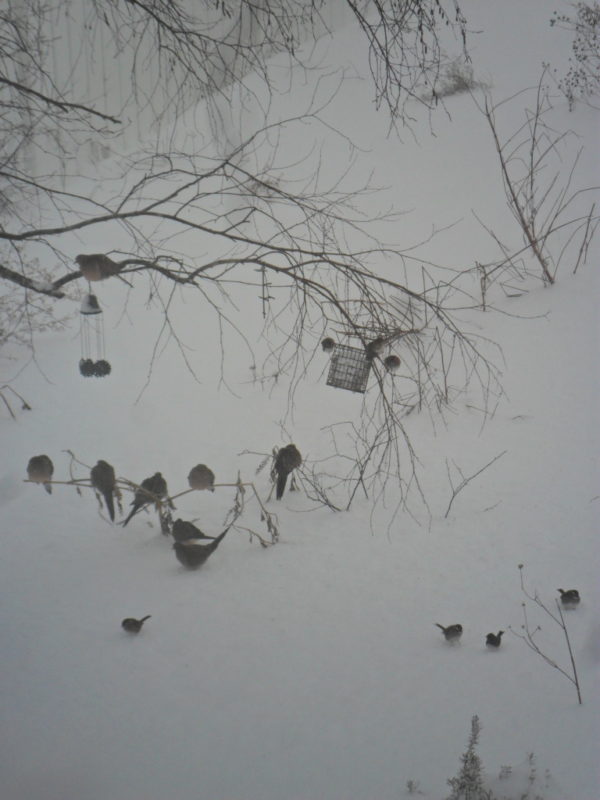
The derivation of the term is probably Celtic, but unclear. It may stem from “i mboc”, literally Old Irish for “in the belly”, a reference to the pregnancy of ewes, which give birth in the very early spring; an alternate name for the holiday is “Oimelc”, which means “ewe milk”, tying it more firmly to pastoral origins. Imbolc may also derive from “imb fholc”, an Old Irish term indicating the washing or cleansing of oneself in a ritual fashion, which connects to the Christianized celebration of Mary’s postpartum purification. Still others suggest a link to the Proto-Celtic “embibolgon,” which means “budding”, a reference to the first swellings observable in nature at this time. By Imbolc, or soon after, it is not uncommon to see early spring bloomers such as snowdrop or winter aconite in the garden, with hellebores and witch hazel to follow shortly.

Wherever the name comes from, Imbolc’s traditional colors are red and white, but you don’t find a lot of Imbolc decorations at Target and Walmart. However, Valentine’s Day, just 12 days later, has lots of merch, and its colors blend nicely with those of the ancient festival, so that’s the theme I focus on for my décor at this season.

Weather divination for the coming spring was common at Imbolc, with special attention paid to wind, rain and snow on the day, as forecasters of the conditions to be encountered ahead. The general rule was, the nastier the day, the better the future. The behavior of birds and wild animals on this date was also noted as portents of the growing season. Some of these traditions have descended into modern times with the celebration of Groundhog Day on February 2nd, a relic of beliefs brought to America by German immigrants. According to that custom, if the groundhog, a large hibernating rodent, comes out from his burrow on a cloudy day, and fails to see his shadow, an early spring is foretold; but if he is startled by his shadow under sunny skies and retreats into his home, there will be six more weeks of winter. A similar folklore regarding the skies for this date comes to us in a rhyme from old England: “If Candlemas be fair and bright, Winter will have another flight” (that is, continue longer), essentially saying the same thing – cloudy skies produce warm weather, sunny skies promote sustained cold.
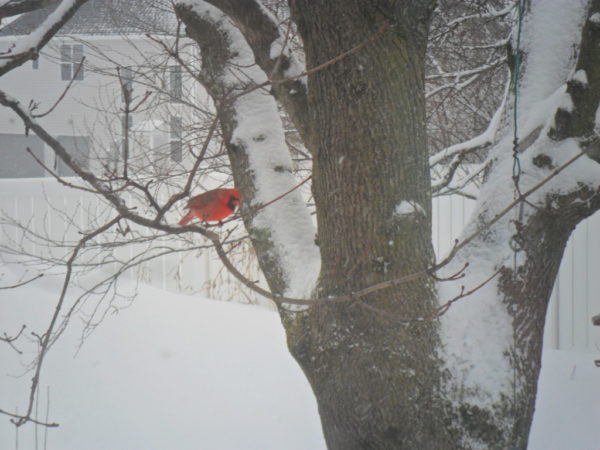
Here in Nazareth, we couldn’t have had much cloudier skies on Imbolc 2021, with hangover snow showers all day from a huge Nor’easter the day before, which produced a record 36” snowfall! “I’m dreaming of a white Imbolc” was on my lips as I shifted tons of the white stuff from porch stoops and cut paths to the bird feeders through five-foot drifts (thankfully I employ a plow service for the driveway). In Philadelphia a white Imbolc was extremely rare, and despite the extra effort of shoveling, I enjoyed the seasonally appropriate views of my backyard, and watching my avian friends feasting on suet and a selection of seeds, knowing I was helping them stave off starvation.
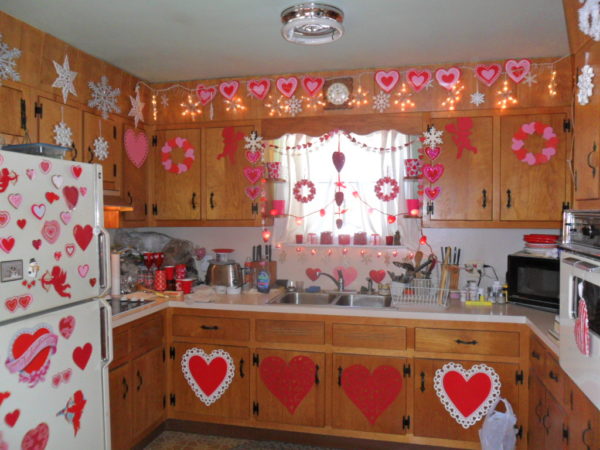
My parents were avid birders, and feeding in the winter has been a decades-long practice on the property. But with the nutrient-rich fallow fields just behind me torn up for housing in the last two years, I bumped up the quantity of feeders put out by my father, to supplement the birds’ diet and make up as best I could for lost habitat. I added a larger seed feeder and a suet cage to the maple outside the back stoop, and hung a feeder and suet cage in the triple birch clump at the southeast corner of the house as well. Observing the feeding frenzy post-blizzard, I have also invested in another pair of seed and suet feeders, which I will place in the paper birch at the far southwest corner, as soon as the snowdrifts recede enough to make that journey a practical one.
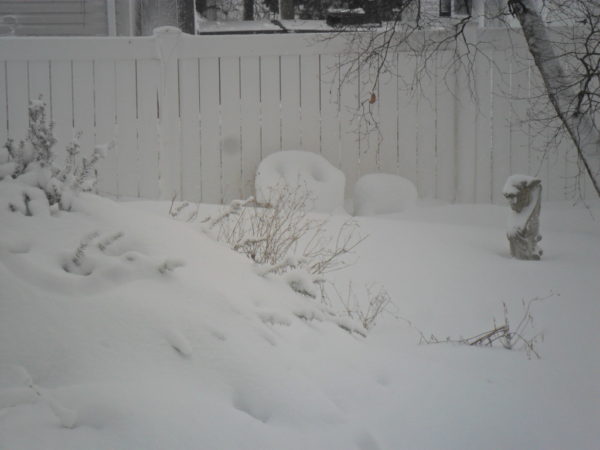
We’ve always had a diverse mix of birds on the property; mostly juncos and a variety of sparrows, we still see the occasional purplish house finch, whose populations were decimated by disease several decades ago. Three or four brilliant red male cardinals are frequent visitors, along with a pair of the more subtly-colored but beautiful females, as are black-capped chickadees, tufted titmice, comic backwards-climbing nuthatches, and a host of grey-brown mourning doves. The Downy woodpecker, with his tiny dot of red atop his petite six-inch frame, comes daily to the suet; more rarely we’ll see his larger relative, the Red-bellied woodpecker (his belly isn’t really red, just barely blushed, but he is so-named to distinguish his smaller red cap from his fully-cloched Redheaded woodpecker cousin). Speckle-coated starlings, demon-eyed grackles and ebony crows pay occasional visits, and you always know there’s a hawk within range when the incessant chatter ceases abruptly. Once in a blue moon we’ll see a blue jay, but as they are harbingers of discord, I don’t miss their absence.

A number of daffodils had begun poking nosy fingers through the earth before the unexpected blizzard, but have no fear – they are tough customers and well prepared for such snowy setbacks. In fact, the snow cover does the entire garden good, protecting it from bitter winter winds and subfreezing temps, and I was glad to have it before another Arctic air mass descended from Canada. By the time this snow “is all”, as my PA Dutch forebears would phrase it, I expect these early daffs will be accompanied by dozens, perhaps hundreds more, coaxed into life by the warmth under their white blanket, and the resulting moisture as it melts. Over the past two autumns, I’ve put in a total of more than 1200 spring-flowering bulbs, so the show should be quite something, starting in a month or so.
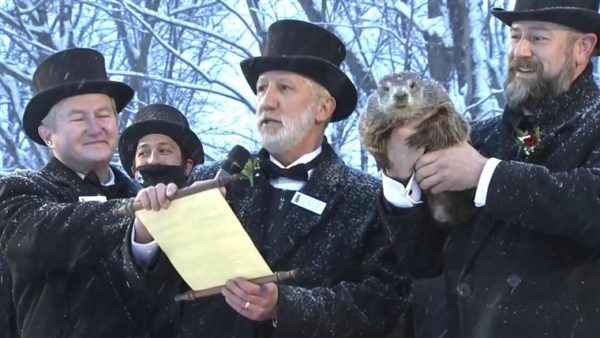
I’ve celebrated Imbolc my entire life, in the form of Groundhog Day; with the nation’s premiere rodent prognosticator, Punxsutawney Phil, just a few hundred miles away, the festivities on Gobbler’s Knob (complete with the Mayor in top hat and tails) were always fodder for local TV stations, and his meteorologic pronouncements eagerly anticipated. Of course Valentine’s Day was fairly universally celebrated, from the homemade heart-covered shoebox mailboxes of my Elementary School days, stuffed with my classmates’ punning cards, to the current hoarding of seasonal-only offerings from Lindor Chocolates (I will kill for their white chocolate-strawberry truffles). These are set dates on the Wheel of the Year, but there’s another floating holiday which has strong regional roots and nostalgic childhood associations for me, which often falls near Imbolc.
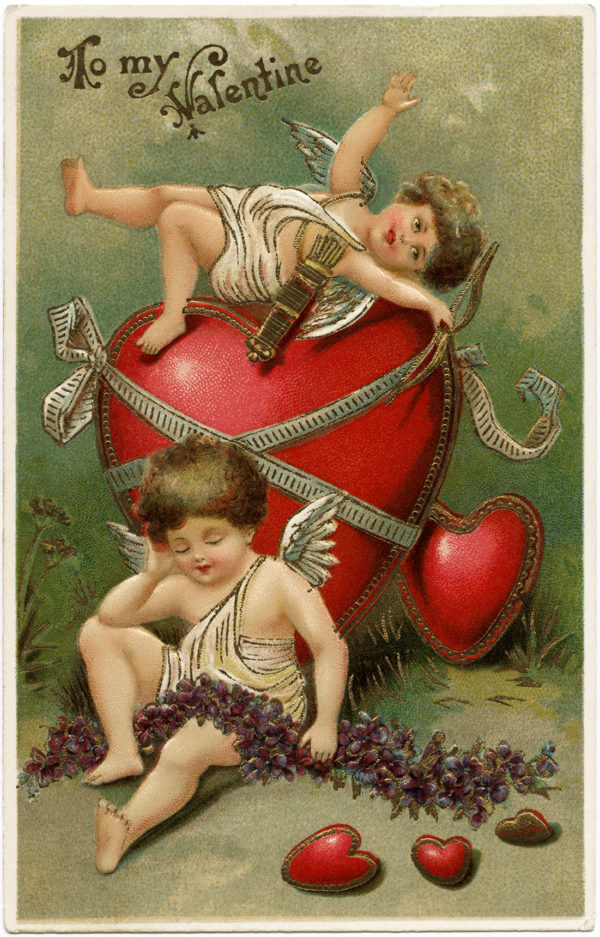
I’m talking about Fastnacht, which you probably know better as Mardi Gras, celebrated this year on February 16th. Literally “fast night” in German, Fastnacht (pronounced “fahst-nahkt) marks the day before the Lenten fast begins on Ash Wednesday. No New Orleans-style parades of fantastical floats, garish garb or semi-nude females collecting beads for the stolid Dutch. In fact, most don’t even observe Lent, in any significant manner, but we do fry up a lot of doughnuts! The tradition of fried foods on Fastnacht (AKA “Fat Tuesday” and “Donut Day”), particularly pastries, stems from the need to divest households of every form of animal product before the Lenten prohibition on meat ensued. Lard was the preferred medium for frying in those days, and as an animal fat, the lard had to go, so “waste not, want not” being part of the PA Dutch credo, we went on a frying spree to use it up, even if we weren’t about to adhere to that “no meat” rule in the coming weeks.

Fastnachts are a special type of doughnut made only that day. Potato-based, they can be plain, glazed, or liberally dusted with powdered sugar, light and airy, with a crispy crust. My grandmother and my Aunt Betty both made fastnachts at home, and I have fond memories of sitting in Nana’s kitchen, hearing the oil spit as the yeasted dollops were dropped into the pan, greedily eyeing the bowl of powdered sugar and cradling my mug of hot cocoa closely as I waited breathlessly for the first browned offerings to hit the drying rack. There never was, or will be, anything quite so satisfying as a fresh, warm fastnacht quickly snatched from the rack before the heavy wooden spoon could descend upon my knuckles in admonishing retribution for my theft.
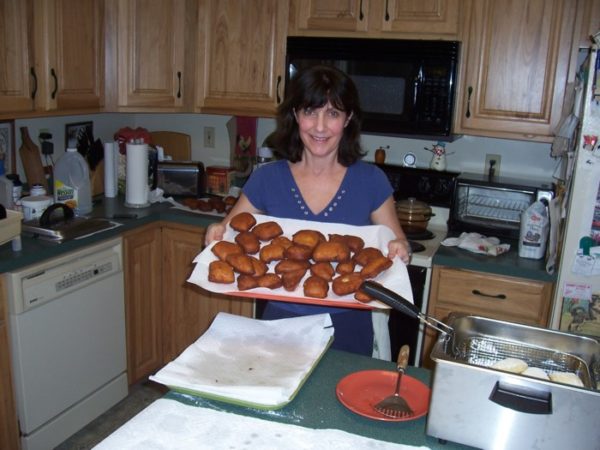
Years after we closed down our personal fastnacht factory, I attempted to make these once, a decade ago, with my cousin Lori. Let’s just say it’s a lot of work, and I swiftly developed a greater appreciation for the sacrifices made by my elders on my behalf when I was growing up! Once a staple of the local community, easily attainable in dozens of shops and church fundraisers, fastnachts are becoming harder and harder to find commercially (at least the genuine article, though there are plenty of impostors), and the bakery which was my local outlet closed last year after the owner died. But I found a new supplier for my yeasted addiction, and we’ll be testing the quality of their goods next week. I blush to admit how many years, marooned in Philadelphia, I passed off Dunkin Donuts as fastnachts, but hopefully with my return to my birthplace, those days are over!

Of course, as with all seasons, decorating is an essential element of the Imbolc holiday for me. But I don’t start the Imbolc landscape from scratch; rather, I retain the more wintry elements from the Yule display as a backdrop. Snowflakes, snowmen, icicles, pine cones and cardinals remain, as well as the “White Yule” collection, with those Santas, in tones from cream to silver, rechristened as “Winter Wizards”. Winterberry is allowed, but not holly – by pagan tradition all evergreens must be removed by Imbolc eve; to leave them out longer is to court disaster.

I supplement with bouquets of silk roses, in various shades of red and pink, a traditional Valentine offering, and also drag out a half dozen small pots of artificial snowdrops, as one of the earliest harbingers of spring. And then, of course, hearts!

Hearts, hearts, and more hearts! In every conceivable shape and size – boxes, tins, votive candleholders, window clings, garlands, hanging ornaments and plaques, magnets, rugs, tea towels, potholders and light strings. Paper hearts, fabric hearts, resin hearts, glass hearts, metallic hearts, wood hearts, ceramic hearts, lace hearts, plastic hearts, wax hearts. The house is a riot of reds, pinks and pale purples. There are some cupids, too, but these are surprisingly difficult to find, so just a smattering is sprinkled throughout the collection.

For a variety of reasons, I hadn’t done a full-blown Imbolc display in four years, and it was wonderful being reunited with so many old friends this year. This collection isn’t on display long; typically it’s not ready until the last week in January, and starts to come down a week after Valentine’s, to make way for spring and St. Patrick’s Day. But it’s fun while it lasts, and at just two dozen boxes, it’s a breeze to pack up.

It’s been quite awhile since I’ve done an Imbolc Feast as well, and this year, with its COVID-19 restrictions, was not the time to revive the custom. But back in the day, Imbolc was the setting for my “Pink and Red Dinner.” The starter was a sumptuous salad of steamed shrimp on a bed of redleaf lettuce and radicchio, with supremes of blood orange, sliced roasted beets, and slivers of red onion, dressed with a raspberry vinaigrette. The main course was scallops in a blush Alfredo sauce, tinted pink with a bit of tomato paste, on a bed of tomato fettuccine, accompanied by roasted tomatoes and shallots, washed down with a pale pink White Zinfandel. Dessert might be raspberry cheesecake, a red velvet cake from a heart-shaped pan, iced with pink-dyed cream cheese frosting, or a strawberry mousse. Those were the days!
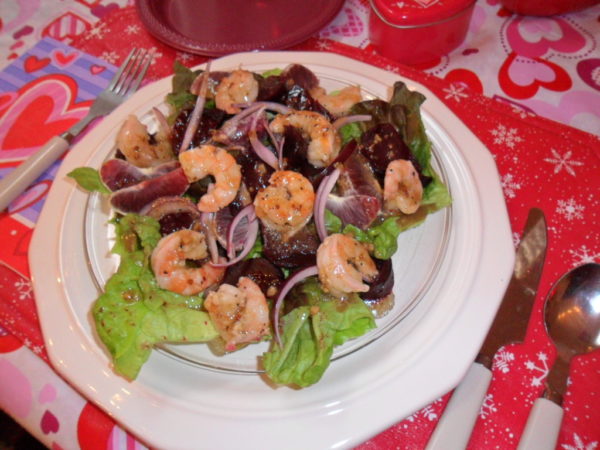
This year I had frozen leftovers from my Thanksgiving dinner; it simply didn’t make sense to go to any trouble for just me. But I did squirrel away a bag of those white chocolate-strawberry truffles from Lindor – pure heaven!

I enjoy seeing the snowy landscape, a sight which has become all too rare in recent decades, as average temperatures rise and weather patterns alter. With a yard-deep covering and fresh coatings applied every few days, I may get my fill of the stuff by February’s end, but for now it’s time to relax and settle in with a bowl of steaming mushroom barley soup, pore over seed catalogs, read a good book while cranking the Albinoni oboe concertos on the computer, and dream of basketsful of spring blooms to come.
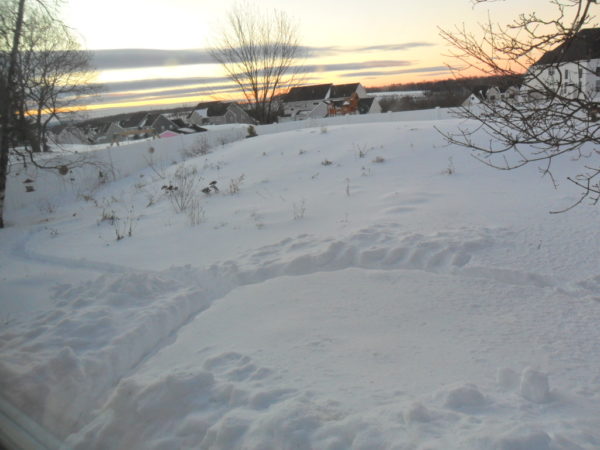
To Winter! Long may she reign!


3 comments, add yours.
Jacqueline
Love Winter!!! My birth came the day after the groundhog appeared. I’m always hoping he sees his shadow. Never can get enough of winter scenes. Thanks for sharing, Alex!
Laurien
You’ve outdone yourself with decorations again, Alex! Wonderful that you help out the birds in winter. We do too but don’t have your variety. Appreciated the photos of the tufted titmouse, red cardinal, and mourning doves, none of which live in our area. So glad you have found a new supplier for your fastnacht and will enjoy a well-deserved treat. Thanks for sharing this with your readers, Alex!
robert Martin denk
Pretty “cool”, Alex. Glad you got the snow, and in Minnesota this year, not so much! It’s an ice box, here, instead!